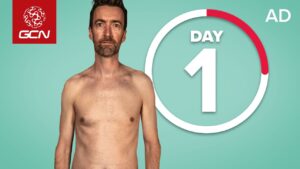We Tried To Copy A Pro Cyclist’s Diet | Did We Puke? with GCN
Source: GCN Youtube Channel: We Tried To Copy A Pro Cyclist’s Diet | Did We Puke?
Video We Tried To Copy A Pro Cyclist’s Diet | Did We Puke? with Global Cycling Network
Video We Tried To Copy A Pro Cyclist’s Diet | Did We Puke? with Global Cycling Network YouTube Channel.
We Tried To Copy A Pro Cyclist’s Diet | Did We Puke?
The Global Cycling Network is a hub for cyclists of all levels looking to improve their performance and overall enjoyment of the sport. Professional cyclists are known for consuming large amounts of carbohydrates during races to sustain their energy levels and ride at high speeds for extended periods. This practice has become standard in the cycling world, with riders typically aiming to consume around 60 grams of carbohydrates per hour during long rides. However, the question arises: what would happen if amateur cyclists tried to fuel like the pros and consumed even larger amounts of energy?
In a YouTube experiment conducted by GCN, Hank, a non-professional cyclist, attempted to consume 120 grams of carbohydrates every hour for 6 hours while riding. This fueling strategy was based on the recommendations of Precision Fuel and Hydration, a company that works with top athletes and cycling teams to optimize performance through nutrition. Although this experiment was purely observational and not recommended for amateur cyclists to try at home, it shed light on the effects of high carbohydrate intake during intense physical activity.
Before embarking on the 6-hour ride, Hank preloaded with electrolytes and a high-carb breakfast to fuel his body for the challenge ahead. Throughout the experiment, Hank struggled to consume the recommended amount of carbohydrates, experiencing stomach discomfort, bloating, and a general feeling of malaise. Despite the initial challenges, Hank noted an improvement in his energy levels and performance compared to previous rides where he under-fueled. This highlighted the importance of proper nutrition and fueling for cyclists, even at the amateur level.
As the experiment progressed, Hank faced increasing difficulties digesting the high amount of carbohydrates, leading to discomfort and a decrease in overall well-being. The lack of scientific research on this specific topic made it challenging to predict the exact outcomes of such a high-carb intake for amateur cyclists. However, anecdotal evidence from endurance events suggested that many riders struggle to sustain this level of fueling over extended periods.
The experiment also raised awareness of the differences in fueling requirements between professional and amateur cyclists. While pro riders often consume upwards of 120 grams of carbohydrates per hour during intense races, the average cyclist may not need such high levels of fueling for their normal training rides. Factors such as intensity, duration, and individual physiology play a significant role in determining the optimal fueling strategy for each rider.
Overall, the GCN experiment showcased the importance of proper nutrition and fueling for cyclists of all levels. While attempting to replicate the fueling practices of professional riders may not be necessary or beneficial for amateur cyclists, understanding the role of carbohydrates in performance can lead to improved energy levels and endurance on the bike. Finding a balance that works for individual needs and training goals is key to unlocking the full potential of cycling as a sport and a lifestyle.
The opinions expressed in this space are the sole responsibility of the YouTube Channel Global Cycling Network and do not necessarily represent the views of CicloNews.










